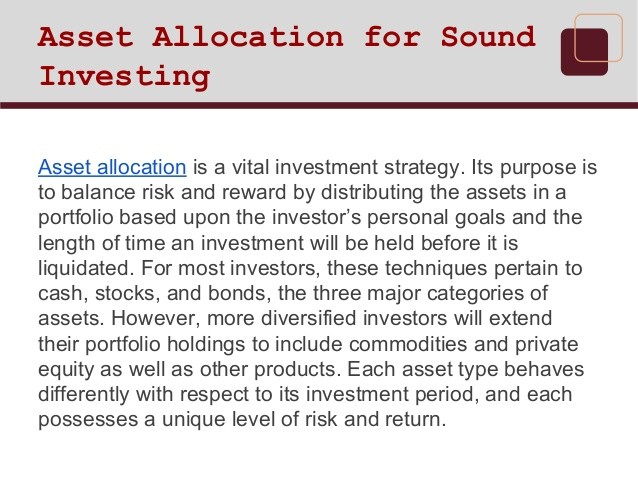Asset Allocation A Sound Investment Strategy
Post on: 1 Апрель, 2015 No Comment

- What Is Asset Allocation?
- Stocks, Bonds, and Money Markets
- Risk Reward Map
- Diversification: The Foundation of Asset Allocation
- Sample Asset Allocations
- Asset Allocation Can Work
- A Simple Process, Some Dramatic Potential Results
- Points to Remember
In today’s complex financial markets, you have an impressive array of investment vehicles from which to select. Each investment also carries some risks, making it important to choose wisely if you are selecting just one.
The good news is that there’s no rule that says you must stick with only one type of investment. In fact, you can potentially lower your investment risk and increase your chances of meeting your investment goals by practicing asset allocation.
What Is Asset Allocation?
Asset allocation refers to the way in which you weight diverse investments in your portfolio in order to try to meet a specific objective. For instance, if your goal is to pursue growth (and you’re willing to take on market risk in order to do so), you may decide to place 20% of your assets in bonds and 80% in stocks.
The asset classes you choose, and how you weight your investment in each, will probably hinge on your investment time frame and how that matches with the risks and rewards of each asset class.
Stocks, Bonds, and Money Markets
Here’s a closer look at the risk and reward levels of the major asset classes:
- Stocks — Well known for fluctuating frequently in value, stocks carry a high level of market risk (the risk that your investments’ value will decrease after you purchase them) over the short term. However, stocks have historically earned higher returns than other asset classes by a wide margin, although past performance is no predictor of future results. Stocks have also outpaced inflation — the rising prices of goods and services — at the highest rate through the years, and therefore carry very low inflation risk.
- Bonds — In general, these securities have less severe short-term price fluctuations than stocks, and therefore offer lower market risk. On the other hand, their overall inflation risk tends to be higher than that of stocks, as their long-term return potential is also lower. Bond returns may be influenced by movements in short-term interest rates. When interest rates rise, bond prices are likely to fall.
- Money market instruments 1 — Among the most stable of all asset classes in terms of returns, money market instruments carry very low market risk. At the same time, these securities don’t have the potential to outpace inflation by as wide a margin through the years as stocks. Investment in a money market fund is neither insured nor guaranteed by the U.S. government, and there can be no guarantee that the fund will maintain a stable $1 share price. The fund’s yield will vary.
Different investments offer different levels of potential return and market risk. Unlike stocks and corporate bonds, government T-bills are backed by the full faith and credit of the United States, although money market funds that invest in them are not. Past performance is not indicative of future results.
Sources: Standard & Poor’s; Center for Research and Security Prices; Morgan Stanley; Barclays Capital; the Federal Reserve. U.S. stocks are represented by the total returns of the S&P 500 index; midcaps by the total returns of the S&P MidCap 400 Index; small caps by the total returns of a composite of the CRSP 6th-10th decile portfolios and the S&P SmallCap 600 index; foreign stocks by the total returns of the MSCI EAFE Index; bonds by the total returns of the Barclays U.S. Aggregate Bond index; and cash by a composite of yields on 3-month Treasury bills and the total returns of the Barclays 3-Month Treasury Bellwethers index. Index performance assumes reinvestment of dividends, interest and other investment proceeds, but does not account for any fees, commissions, taxes, or expenses incurred by actual investments. Investors cannot directly purchase an index. (CS000136)
Diversification: The Foundation of Asset Allocation
Before exploring just how you can put an asset allocation strategy to work to help you meet your investment goals, you should first understand how diversification — the process of helping reduce risk by investing in several different types of individual funds or securities — works hand in hand with asset allocation.
When you diversify your investments among more than one security, you help reduce what is known as single-security risk, or the risk that your investment will fluctuate widely in value with the price of one holding. Diversifying among several asset classes increases the chance that, if and when the return of one investment is falling, the return of another in your portfolio may be rising (though there are no guarantees). Neither asset allocation nor diversification guarantees against investment loss.
For example, in 2008, large-company stocks lost 37.0%, while long-term government bonds returned 22.7%.2 (Keep in mind that past performance cannot guarantee future results.)
Sample Asset Allocations*














